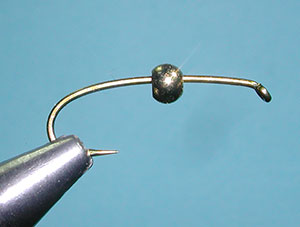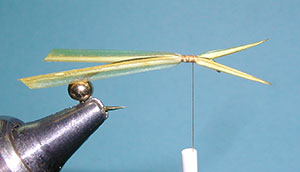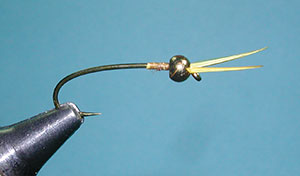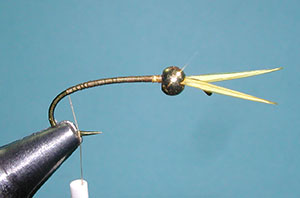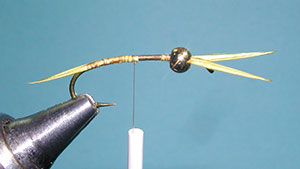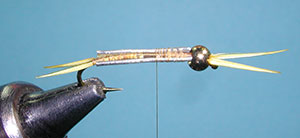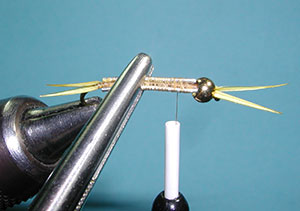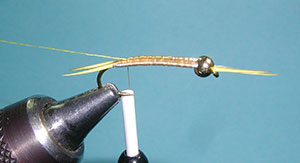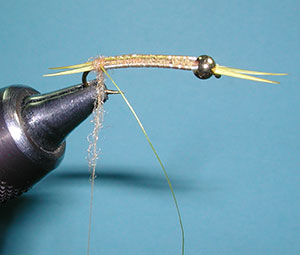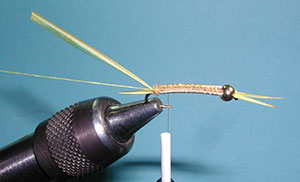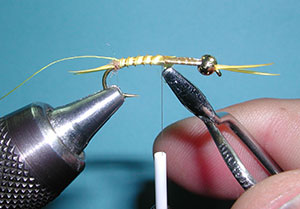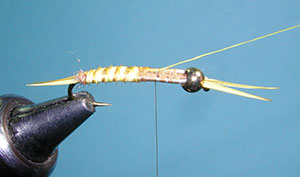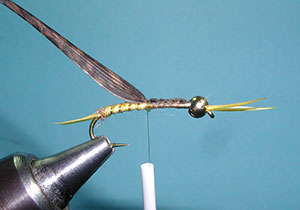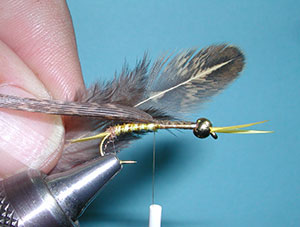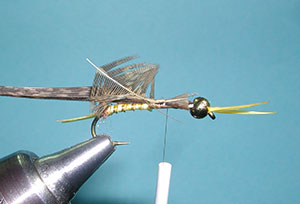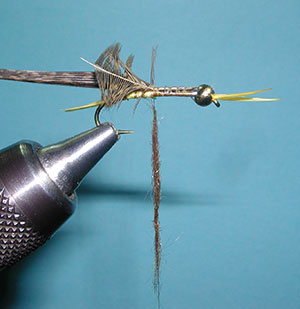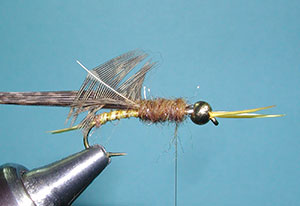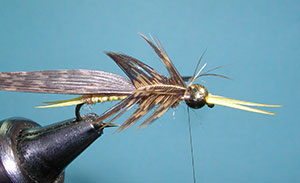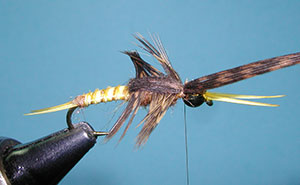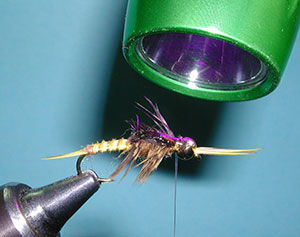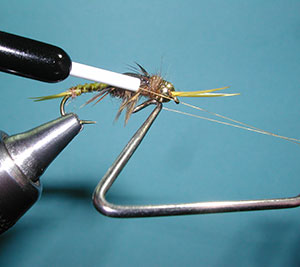Poxyback Biot Stonefly Nymph – get great results year round

Poxyback Biot, Golden Stone
Tying Instructions
| Materials
to Order Material, click the link |
|
|---|---|
| Hook | TMC 2302 #8-12 |
| Thread | Uni-thread Tan 8/0 |
| Head | Gold Tungsten Bead |
| Weight, Underbody | 0.020 Leadfree wire |
| Body | Sulfur Orange Turkey Biot |
| Thorax | Mottled Nymph Dubbing, Hares Ear |
| Tail and Antennae | Sulfur Orange Turkey Biot |
| Collar | Mottled Nymph Dubbing, Hares Ear |
| Wingcase | Dark Mottled Turkey coated with Loons Fly Finish, Thin |
| Legs | Mottled Brown Henback fibers |
| Ribbing | Veevus 10/0 Yellow thread |
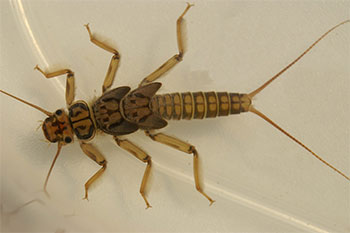
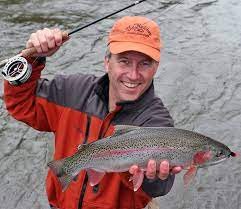
Mike Mercer
Poxyback Biot Stonefly Nymph
The Poxyback Biot Stonefly Nymph was developed by Mike Mercer of Redding, CA in the early 1990’s. Golden Stone nymphs are smaller and lighter in color than salmonflies. They also have a flatter body profile. The belly’s are a rich golden color while the dorsal portion is usually dark. The abdomens have distinct bands and the legs are heavy and bulky. Mike was able to get the flattened body profile by utilizing two strands of lead wire along the shank and wrapping a third strand around the thorax region, gently mashing it down into a planar shape.
Biot Abdomen
The original Poxyback, Golden Stone utilized a dubbed abdomen which was teased out to represent the thin appendages of the actual insect. This was a technique he used on his mayfly Poxyback patterns. Mike refined his pattern with the BH Poxyback, Biot Golden Stone in which turkey biots represent the abdomen in a more realistic way. The biots produces a naturally ribbed segmentation appearance and the Turkey Biot’s are thin enough to represent the whip-like tails and antennae. He included a bead head and and his “signature” epoxied wingcase.
Two Colorations
The pattern has been adapted to many types of stoneflies, ie skwalas, goldens, little browns. Two basic colorations apply, Light and Dark. The dark coloration is used under turbid conditions while the light is used when the water is clear. Mike also designed two size ranges for the stoneflies. The standard size is #8-12 and the micro pattern is #14-18. Since stoneflies are present year-round in the stream, these size ranges and colors will cover all of your stonefly nymphs.
Presentation
You can use these patterns when searching for trout or for a realistic imitation during a hatch. If you are searching, try this pattern in the riffles and current seams, near rocky structures and streamside vegetation. Stoneflies like freestone streams. During Mid-March, the Skawalas will be hatching and in late May and June, the golden stoneflies will crawl along the bottom to reach shore.
Trout will often locate themselves close to shore to intercept the stoneflies while staying in the edges of pockets and slots. The nymphs do not have good swimming abilities and are often swept up in the current. A drift-free presentation of the nymph within the feeding lanes will often produce results. Depending upon the water, some use indicators while others prefer to high-stick nymph without indicators.
Variations

Poxyback Dark Stone
| Hook | TMC 2302 #8-12 |
| Thread | Danville Black 6/0 |
| Head | Black Tungsten Bead |
| Weight, Underbody | 0.020 Leadfree wire |
| Body | Mahogany Turkey Biot |
| Thorax | Mottled Nymph Dubbing, Chocolate |
| Tail and Antennae | Brown Goose Biot |
| Collar | Mottled Nymph Dubbing, Chocolate |
| Wingcase | Dark Mottled Turkey coated with Loons Fly Finish, Thin |
| Legs | Mottled Brown Henback fibers |
| Ribbing | Veevus 10/0 Brown thread |
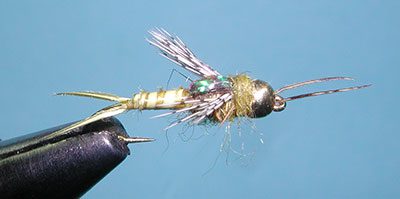
Poxyback Micro Stonefly, Light
| Hook | TMC 200R #14-18 |
| Thread | Danville Lt. Olive 6/0 |
| Head | Gold Tungsten Bead |
| Underbody | Olive Mottled Nymph Dubbing |
| Body | Turkey Biot, PMD |
| Thorax | Olive Mottled Nymph Dubbing |
| Tail | Turkey Biot, PMD |
| Antennae | Pheasant fibers |
| Collar | Olive Mottled Nymph Dubbing |
| Wingcase | Mottled Turkey and strand of Olive Krystal Flash coated with Loons Fly Finish, Thin |
| Legs | Partridge |
| Ribbing | Veevus 10/0 Yellow thread |
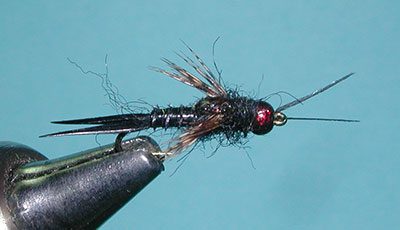
Poxyback Micro Stonefly, Dark
| Hook | TMC 200R #14-18 |
| Thread | Danville Black 6/0 |
| Head | Black Tungsten Bead |
| Underbody | Black Mottled Nymph Dubbing |
| Body | Turkey Biot, Black |
| Thorax | Black Mottled Nymph Dubbing |
| Tail | Turkey Biot, Black |
| Antennae | Black Pheasant fibers |
| Collar | Mottled Nymph Dubbing, Black |
| Wingcase | Mottled Turkey and strand of Black Krystal Flash coated with Loons Fly Finish, Thin |
| Legs | Mottled Brown Henback fibers |
| Ribbing | Veevus 10/0 Yellow thread |

